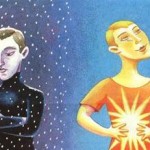There is a distinctive pallor that comes over our world at this time of the year; grey parking lots seem a lot harsher, people wandering into Starbucks this morning a tad glummer. But nothing seems tougher to deal with than a dearth of sunshine. It feels as though Mother Nature has pulled down the shades and they ain’t coming back up anytime soon.
As I scrape the shellacking of quarter-inch ice off my windshield at 6 a.m. that had built up overnight before I drive into work, I find myself pining for spring, for the sweet smell of the soil bursting back to life. But most of all, I yearn for the return of more sunny days, to the end of the great ball of light’s hibernation.
“One must maintain a little bit of summer, even in the middle of winter” wrote Henry David Thoreau. Well, that’s not always easy for those of us stuck in office buildings behind desks.
For some, the lack of sunshine actually causes a type of depression called Seasonal Affective Disorder (SAD); a syndrome of god-awful crummy symptoms that affects about 14 million Americans during the winter. Symptoms of SAD include decreased concentration, increased appetite, weight gain (whereas some other forms of depression can lead to weight loss), social withdrawal, moodiness, and fatigue.
Some people chalk these nagging symptoms up to just being down in the dumps when in reality, SAD is really a form of clinical depression. SAD is highly dependent on a person’s hormonal state, seasonal characteristics like ambient temperature, and exposure to natural light (which can influence the body’s production of melatonin). Research has linked the prevalence of SAD to higher latitudes, regions that tend to have more intense and longer winters. Just great, I thought. I live in Buffalo, New York.
But the lack of sun just doesn’t cause depression in those who might not ordinarily have it. One study found that a lack of sunshine actually may cloud memory and other thinking functions in some people who already have depression to begin with. Depressed adults from the least sunny areas were more than twice as likely to have impairments in memory and cognitive functions as those with the greatest sun exposure. The sunshine-cognition link was not seen in adults without depression, however.
Here are some ideas to start feeling better:
Shake it in the morning. For those afflicted with SAD, the time of day you work out matters. Studies show that morning exercisers report better sleep, burn up more calories throughout the day, and have lower blood pressure. Even if you don’t make it to the gym, just walking outside in the morning can really help.
Avoid the Pit Stop at The Olive Garden. When I read that white pastas, bagels and bread could lower my mood, I just switched off my computer in protest – I love pasta as much as my mom and there’s no way I can possibly give it up. But I started watching as my mood did dip after consuming a leviathan portion of rigatoni. That’s so because simple carbohydrates – think white flour stuff – give us short-lived every boost, so it’s only a matter of time before we reach for that second helping of cake spackled with butter-cream frosting. Instead, choose foods rich in protein and complex carbohydrates which release sugar into the body slowly and have a low glycemic index. Check out foods that will actually help lift your mood.
Fill Up Your Calendar. I know, I know. It’s six o’clock and you just pulled in the darkened driveway on a freeze-your-ass-off day and you just want to eat dinner and park yourself in front of the old T.V. Even on weekends. Yet research shows that people who suffer from depression report higher levels of well-being and satisfaction after positive social interactions. Feeling a sense of belonging makes us all feel better, but all the more so when you’re feeling down.
Sleepless in Seattle. Getting less slumber during these darkened days sounds like a crazy prescription for lifting one’s mood. When we feel down and the world is dark, it seems like more sleep is what’s called for to make us feel better. Not so say scientists. Instead, it’s very important to maintain a steady rhythm of sleep per night by waking up and going to bed at the same times every day – including weekends.
Light the (Artificial) Light Shine In. A light therapy regimen can significantly reduce SAD symptoms, regardless of the condition’s severity. Light therapy boxes range in brightness and type of light, so consult a physician before buying one.
Read Up. Pick up a copy of Winter Blues by Dr. Norman Rosenthal, the psychiatrist who came up with the SAD term and has studied it extensively. Check out his very informative website.
They say time heals all things. If we can hang on just long enough, the days start getting longer and the sunshine becomes more plentiful. In meanwhile, try these tips to make things more bearable and remember what the French philosopher Albert Camus once wrote,
“In the depth of winter, I finally learned that within me there lay an invincible summer.”













